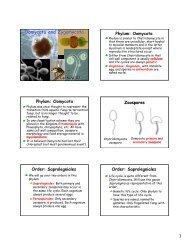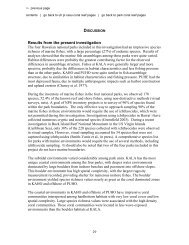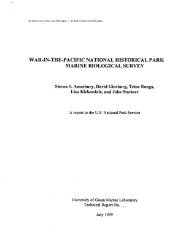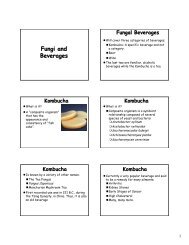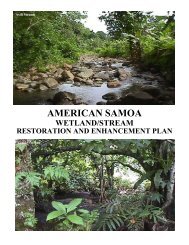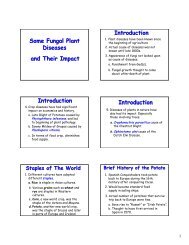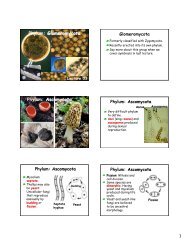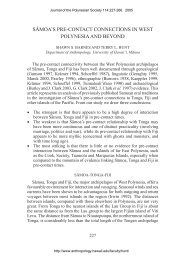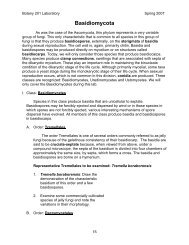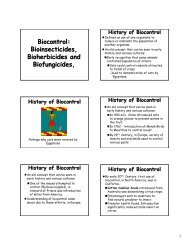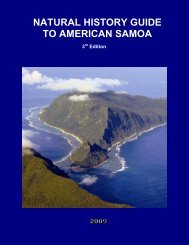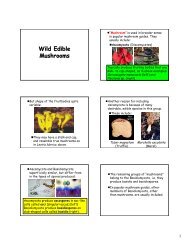distribution, status, and conservation of bats in the fiji islands
distribution, status, and conservation of bats in the fiji islands
distribution, status, and conservation of bats in the fiji islands
Create successful ePaper yourself
Turn your PDF publications into a flip-book with our unique Google optimized e-Paper software.
Key sites <strong>and</strong> areas for <strong>conservation</strong><br />
macdonaldi, which may have a few thous<strong>and</strong> <strong>in</strong>dividuals. Several hundred or even a few<br />
thous<strong>and</strong> swiftlets make <strong>the</strong> estimation <strong>of</strong> <strong>the</strong> numbers <strong>of</strong> <strong>bats</strong> present very difficult.<br />
We did not get any evidence that <strong>the</strong>se <strong>bats</strong> are presently taken by local people, but <strong>the</strong><br />
proximity with a large village makes this quite likely. However, enter<strong>in</strong>g <strong>the</strong> cave is not<br />
easy because <strong>of</strong> <strong>the</strong> stream, which at <strong>the</strong> time <strong>of</strong> our visit had a fairly strong current. This<br />
colony has been known to <strong>the</strong> scientific community s<strong>in</strong>ce at least 1912 (Andersen 1912, <strong>in</strong><br />
Mickleburgh et al. 1992). It would be important to br<strong>in</strong>g to <strong>the</strong> attention <strong>of</strong> <strong>the</strong> people <strong>of</strong><br />
Kalabu <strong>the</strong> significance <strong>of</strong> <strong>the</strong> bat colony that roosts <strong>in</strong> <strong>the</strong>ir cave.<br />
The cave is on <strong>the</strong> edge <strong>of</strong> Colo-i-Suva Forest Park, <strong>and</strong> consequently its <strong>bats</strong> are<br />
presumably important poll<strong>in</strong>at<strong>in</strong>g agents <strong>in</strong> that area <strong>and</strong> adjacent forests.<br />
5.7. Wa<strong>in</strong>ibuku Cave<br />
Kalabu (Viti Levu)<br />
Like <strong>the</strong> Kalabu cave, this cave is also about 200 m long by 10-15 m high, <strong>and</strong> cut buy a<br />
stream that still flows through its full length. It harbours a colony with a few thous<strong>and</strong> N.<br />
macdonaldi, <strong>and</strong> very large numbers <strong>of</strong> swiftlets. It is located <strong>in</strong> a rural area but, like <strong>the</strong><br />
Kalabu cave, is immediately adjacent to <strong>the</strong> Colo-i-Suva Forest Park.<br />
The fact that this colony is just 3 km north <strong>of</strong> ano<strong>the</strong>r important colony (Kalabu) suggests<br />
that caves suitable to harbour large colonies <strong>of</strong> this species are a limit<strong>in</strong>g resource. In fact,<br />
Viti Levu is almost entirely volcanic, <strong>and</strong> spacious caves are only known <strong>in</strong> a few small<br />
limestone areas. This situation re<strong>in</strong>forces <strong>the</strong> importance <strong>of</strong> preserv<strong>in</strong>g all <strong>the</strong> four caves<br />
where N. macdonaldi is known to roosts <strong>in</strong> Fiji.<br />
In <strong>the</strong> 1970’s Mike Tarburton observed E. semicaudata <strong>in</strong> this cave (personal<br />
communication).<br />
5.8. Caves <strong>and</strong> adjo<strong>in</strong><strong>in</strong>g forests <strong>in</strong> <strong>the</strong> Lau Isl<strong>and</strong>s<br />
(Lau Group)<br />
The isl<strong>and</strong>s <strong>of</strong> <strong>the</strong> Lau group <strong>of</strong>ten have relatively extensive limestone areas, <strong>in</strong> which<br />
<strong>the</strong>re are good numbers <strong>of</strong> large caves (Ladd & H<strong>of</strong>fmaister 1945, Nunn et al. 1991).<br />
Several <strong>of</strong> <strong>the</strong>se caves still harbour colonies <strong>of</strong> Emballonura semicaudata, <strong>and</strong> although<br />
<strong>the</strong>re is evidence that <strong>the</strong> species has decl<strong>in</strong>ed here, <strong>the</strong> situation is certa<strong>in</strong>ly better than <strong>in</strong><br />
<strong>the</strong> larger Fijian isl<strong>and</strong>s <strong>and</strong> <strong>in</strong> most <strong>of</strong> <strong>the</strong> Pacific. The species also survives elsewhere <strong>in</strong><br />
Fiji <strong>in</strong> numbers that deserve <strong>conservation</strong> <strong>in</strong>vestment (e.g. <strong>in</strong> Yaqeta – Yasawa group), but<br />
overall it is <strong>in</strong> Lau that we see <strong>the</strong> best perspectives for its long term preservation. We<br />
visited caves occupied by E. semicaudata <strong>in</strong> <strong>the</strong> isl<strong>and</strong>s <strong>of</strong> Aiwa, Lakeba, Nayau, <strong>and</strong><br />
Cicia, <strong>and</strong> heard credible descriptions <strong>of</strong> <strong>the</strong> presence <strong>of</strong> <strong>the</strong> species on o<strong>the</strong>r isl<strong>and</strong>s <strong>of</strong> <strong>the</strong><br />
group, such as Totoya. It would be important to survey o<strong>the</strong>r isl<strong>and</strong>s to fur<strong>the</strong>r clarify <strong>the</strong><br />
species range <strong>and</strong> <strong>status</strong>, allow<strong>in</strong>g a better identification <strong>of</strong> <strong>conservation</strong> priorities.<br />
The limestone outcrops where we found caves with <strong>bats</strong> are usually covered with native<br />
forest, <strong>and</strong> those forested areas may be very important for <strong>the</strong> survival <strong>of</strong> E. semicaudata<br />
(see discussion <strong>in</strong> species accounts). On some isl<strong>and</strong>s (e.g. Lakeba <strong>and</strong> Cicia) <strong>the</strong><br />
rema<strong>in</strong><strong>in</strong>g forest patches are very small, but a good part <strong>of</strong> Nayau is still forested.<br />
45



